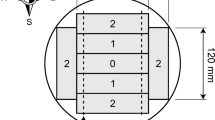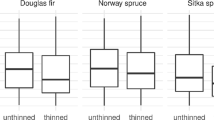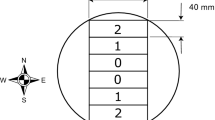Abstract
Context
Rotation length is known to affect timber quality in many plantation species, but its effect on the properties of Sitka spruce (Picea sitchensis) structural timber has not been quantified.
Aim
Te purpose of this study was to compare selected wood properties and grade recovery of Sitka spruce structural timber cut from different radial positions within a log reflecting different cambial ages.
Methods
Structural timber was sawn from 60 logs harvested from an 83-year-old stand in Great Britain. Five specimens were tested from each log: four from consecutive radial positions out from the pith and the fifth a random selection from outside the innermost 15 rings.
Results
Mean modulus of elasticity and bending strength of timber from the outermost radial position were 51% and 41% greater, respectively, than for timber from adjacent to the pith. Wood density differed by 9% between these positions. The amount of distortion (spring, twist and bow), knot frequency and total knot area was significantly higher in timber cut from adjacent to the pith.
Conclusion
Whilst longer rotations result in timber with improved mechanical properties and less distortion, economic and windthrow considerations may limit their implementation in Great Britain.




Similar content being viewed by others
References
Bao FC, Jiang ZH, Jiang XM, Lu XX, Luo XQ, Zhang SY (2001) Differences in wood properties between juvenile and mature wood in 10 species grown in China. Wood Sci Technol 35:363–375
Barrett JD, Kellog RM (1991) Bending strength and stiffness of second-growth Douglas-fir dimension lumber. Forest Prod J 41:35–43
Bendtsen BA, Senft J (1986) Mechanical and anatomical properties in individual growth rings of plantation-grown eastern cottonwood and loblolly pine. Wood Fiber Sci 18:23–38
Bilbis EJ, Brinker R, Carino HF, McKee CW (1993) Effects of stand age on flexural properties and grade compliance of lumber from loblolly pine plantation timber. Forest Prod J 43:23–28
Brazier JD (1985) Juvenile wood. In: Kuchera LJ (ed) Xylorama trends in wood research. Birkhauser, Basel
Brazier JD, Mobbs ID (1993) The influence of planting distance on structural wood yields of unthinned Sitka spruce. Forestry 66:333–352
CEN (1997) Round and sawn timber—method of measurement of features. EN1310:1997. European Committee for Standardisation, Brussels, 15 pp
CEN (2002) Moisture content of a piece of sawn timber—part 1: Determination by oven dry method. EN13183-1:2002. European Committee for Standardisation, Brussels, 5 pp
CEN (2003) Timber structures—structural timber and glued laminated timber—determination of some physical and mechanical properties. EN408:2003. European Committee for Standardisation, Brussels, 13 pp
CEN (2005) Timber structures—Strength graded structural timber with rectangular cross section. Part 1: General requirements. EN 14081–1:2005. European Committee for Standardisation, Brussels, 29 pp
CEN (2009) Structural timber—Strength classes. EN338:2009. European Committee for Standardisation, Brussels, 10 pp
CEN (2010a) Structural timber—determination of characteristic values of mechanical properties and density. EN384:2010. European Committee for Standardisation, Brussels, 19 pp
CEN (2010b) Timber structures—strength graded structural timber with rectangular cross section. Part 2: Machine grading; additional requirements for initial type testing. EN 14081–2:2010. European Committee for Standardisation, Brussels, 21 pp
Clark A III, McAlister RH, Saucier JR, Reitter K (1996) Effect of rotation age on lumber grade, yield, and strength of unthinned loblolly pine. Forest Prod J 46:63–68
Cown DJ, McConchie DL (1982) Rotation age and silvicultural effects on wood properties of four stands of Pinus radiata. N Z J Forestry Sci 12:71–85
Cown DJ, Ball RD, Riddell M, Wilcox P (2002) Microfibril angle in plantation pine: distribution and influence on product performance. IUFRO Working Party S5.01.04 Workshop, Harrison Hot Springs, Canada, September 2002
Duchesne I (2006) Effect of rotation age on lumber grade yield, bending strength and stiffness in Jack pine (Pinus banksiana Lamb.) natural stands. Wood Fiber Sci 38:84–94
Evans R, Ilic J (2001) Rapid prediction of wood stiffness from microfibril angle and density. Forest Prod J 51:53–57
Forest Products Laboratory (2010) Wood handbook: wood as an engineering material. Gen. Tech. Rep. FPL-GTR-113. USDA Forest Service, Forest Products Society, Madison
Forestry Commission (2010) Forestry statistics 2010—a compendium of statistics about woodland, forestry and primary wood processing in the United Kingdom, 208 pp. http://www.forestry.gov.uk/statistics
Ilic J, Northway R, Pongracic S (2003) Juvenile wood characteristics, effects and identification: literature review. FWPRDC Report PN02.1907. Forest and Wood Products Research and Development Corporation, Australia
ISO (1975) Wood—determination of density for physical and mechanical tests. ISO 3131: 1975. International Organization for Standardisation, Geneva
Johansson M, Perstorper M, Kliger R (2001) Distortion of Norway spruce timber—part 2. Modelling twist. Holz Roh Werkst 59:155–162
Jordan L, Daniels RF, Clark A, He R (2005) Multilevel nonlinear mixed-effects models for the modeling of earlywood and latewood microfibril angle. Forest Sci 51:357–371
Kennedy RW (1995) Coniferous wood quality in the future: concerns and strategies. Wood Sci Technol 29:321–338
Kliger IR, Perstorper M, Johansson G, Pellicane PJ (1995) Quality of timber products from Norway spruce—part 3. Influence of spatial position and growth characteristics on bending stiffness and strength. Wood Sci Technol 29:397–410
Koponen T, Karppinen T, Hæggström, Saranpää P, Serimaa R (2005) The stiffness modulus in Norway spruce. Holzforchung 59:451–455
Lachenbruch B, Moore JR, Evans R (2011) Radial variation in wood structure and function in woody plants, and hypotheses for its occurrence. In: Meinzer FC, Dawson T, Lachenbruch B (eds) Size and Age-Related Variation in Tree Structure and Function. Springer Series in Tree Physiology
Larson PR, Kretschmann DE, Clark A III, Isebrands JG (2001) Formation and properties of juvenile wood in southern pines: a synopsis. Gen. Tech. Rep. FPL-GTR-129. U.S. Department of Agriculture, Forest Service, Forest Products Laboratory, Madison, 42 pp
Macdonald E, Hubert J (2002) A review of the effects of silviculture on timber quality of Sitka spruce. Forestry 75:107–138
Macdonald E, Gardiner B, Mason W (2010) The effects of transformation of even-aged stands to continuous cover forestry on conifer log quality and wood properties in the UK. Forestry 83:1–16
McLean JP (2008) Wood properties of four genotypes of Sitka spruce. PhD thesis, Department of Analytical and Environmental Chemistry, University of Glasgow, UK, 269 pp
McLean JP, Evans R, Moore JR (2010) Predicting the longitudinal modulus of elasticity of Sitka spruce from cellulose orientation and abundance. Holzforschung 64:495–500
Miller KF (1985) Windthrow hazard classification. Forestry Commission Leaflet No. 85. HMSO, London
Mochan S, Connolly T (2006) The effect of windblow on the timber quality of Sitka spruce. Scott Forestry 60:15–20
Moore JR, Mochan SJ, Brüchert F, Hapca AI, Ridley-Ellis DJ, Gardiner BA, Lee SJ (2009) Effects of genetics on the wood properties of Sitka spruce growing in the United Kingdom: bending strength and stiffness of structural timber. Forestry 82:491–501
Ormarsson S, Cown DJ (2005) Moisture-related distortion of boards and wooden products of radiata pine: comparison with Norway spruce: Wood Fiber Sci 37:424–436
Perstorper M, Pellicane PJ, Kliger IR, Johansson G (1995) Quality of timber products from Norway spruce. Part 2: Influence of spatial position and growth characteristics on warp. Wood Sci Technol 29:339–352
Pinheiro JC, Bates DM (2000) Mixed-effects models in S and S-Plus. Springer, New York, 528 pp
Pratt JE (1979) Fomes annosus butt-rot of Sitka spruce: II. Loss of strength of wood in various categories of rot. Forestry 52:31–45
Quine CP, Malcolm DC (2007) Wind-driven gap development in Birkley Wood, a long-term retention of planted Sitka spruce in upland Britain. Can J Forest Res 37:1787–1796
Quine C, Coutts M, Gardiner B, Pyatt G (1995) Forests and wind: management to minimise damage. Bulletin 114. Forestry Commission, Edinburgh, 24 pp
R Development Core Team (2010) R: a language and environment for statistical computing. R Foundation for Statistical Computing, Vienna, Austria. ISBN 3-900051-07-0. http://www.R-project.org
Seeling U, Merforth C (2000) FRITS—a new equipment to measure distortion. Holz Roh Werkst 58:338–339
Walker JCF (2006) Primary wood processing: principles and practice, 2nd edn. Springer, Dordrecht, 596 pp
Walker JCF, Butterfield BG (1995) The importance of microfibril angle for the processing industries. New Zeal J Forest 40:34–40
Walker JCF, Nakada R (1999) Understanding corewood in some softwoods: a selective review on stiffness and acoustics. Int Forest Rev 1:251–259
Xu P, Walker JCF (2004) Stiffness gradients in radiata pine trees. Wood Sci Technol 38:1–9
Zobel BJ, Sprague JR (1998) Juvenile wood in forest trees. Springer, Berlin
Acknowledgements
Dr Chris Quine from Forest Research alerted us to the potential opportunity to study the wood properties of older trees at Birkley Wood. The Kielder Forest District staff, in particular Graham Gill, David Woodhouse and Simon Banks, allowed us access to the stand and arranged assistance with felling and processing of the trees. Francis Wilbur from James Jones & Sons sawmills arranged the processing, drying and grading of the timber. Greg Searles assisted with the fieldwork and the mechanical testing. Martin Bacher from MiCROTEC assisted with analysis of the strength grading data. Dr. Barry Gardiner from Forest Research assisted with develo** the original project proposal and, along with Dr. Dan Ridley-Ellis, Dr Dave Auty and Elspeth Macdonald, provided comments on an earlier version of the manuscript. Funding for this study was provided by the Scottish Funding Council and the Scottish Forestry Trust.
Author information
Authors and Affiliations
Corresponding author
Additional information
Handling Editor: Barry Alan Gardiner
Contribution of co-authors
John Moore initiated the study, undertook field and laboratory measurements, analysed the data and wrote the final paper.
Andrew Lyon assisted with develo** the methodology for the study, organised the fieldwork and timber processing in the sawmill, assisted with field and laboratory measurements and contributed to the final report.
Stefan Lehneke assisted with the laboratory measurements and contributed to the final report.
Rights and permissions
About this article
Cite this article
Moore, J.R., Lyon, A.J. & Lehneke, S. Effects of rotation length on the grade recovery and wood properties of Sitka spruce structural timber grown in Great Britain. Annals of Forest Science 69, 353–362 (2012). https://doi.org/10.1007/s13595-011-0168-x
Received:
Accepted:
Published:
Issue Date:
DOI: https://doi.org/10.1007/s13595-011-0168-x




